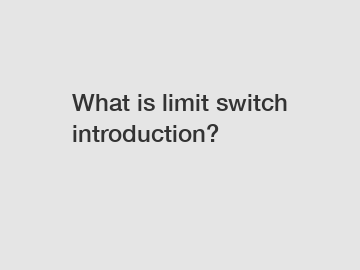What is limit switch introduction?
A limit switch is a fundamental component in the world of industrial automation and machinery. This small yet essential device plays a crucial role in ensuring the proper functioning and safety of various automated systems. But what exactly is a limit switch, and how does it work? Let's delve into the details of this widely used device.
1. What is a limit switch?
A limit switch is a type of sensor that is used to detect the presence or absence of an object in a specific position. It consists of an actuator that is mechanically linked to a set of contacts. When the actuator is activated by the presence of an object, it triggers the contacts to either open or close, thus signaling the system to take a particular action.

2. How does a limit switch work?
Limit switches operate on a simple principle of mechanical movement. When an object comes into contact with the actuator of the switch, it causes the actuator to move, which, in turn, changes the state of the contacts. This change in state is then detected by the control system, which can stop, start, or redirect the movement of machinery or equipment accordingly.
3. Where are limit switches used?
Limit switches are used in a wide range of applications across various industries. They are commonly found in industrial machinery, conveyor systems, elevators, and robotic arms, among many others. Limit switches are particularly useful in automated systems where precise positioning or end-of-travel detection is required.
4. Why are limit switches important?
Limit switches play a critical role in ensuring the safe and efficient operation of automated systems. By detecting the presence or absence of objects in specific positions, limit switches help prevent equipment damage, ensure accurate positioning, and improve overall system reliability. Without limit switches, machinery and equipment would be prone to unpredictable behavior and potential failures.
5. How to choose the right limit switch?
When selecting a limit switch for a particular application, several factors must be considered. These include the type of actuator (such as roller plunger, lever, or spring return), the voltage and current ratings, the environmental conditions (such as temperature and humidity), and the required level of accuracy and repeatability. By carefully evaluating these factors, one can choose the most suitable limit switch for their specific needs.
6. Can limit switches be customized?
Yes, limit switches can be customized to meet the specific requirements of a particular application. Customization options include different actuator types, housing materials, electrical ratings, and mounting configurations. By working with a reputable manufacturer or supplier, one can tailor a limit switch to fit their unique operational needs and constraints.
7. What are the benefits of using limit switches?
Using limit switches offers several key benefits, including enhanced safety, improved system reliability, increased productivity, and reduced maintenance costs. By incorporating limit switches into automated systems, manufacturers can ensure smoother operation, minimize downtime, and ultimately achieve higher levels of efficiency and profitability.
In conclusion, a limit switch is a simple yet indispensable device in the world of industrial automation. By detecting the presence or absence of objects in specific positions, limit switches help ensure the safe and efficient operation of machinery and equipment. With their versatility, reliability, and customizability, limit switches continue to play a vital role in optimizing automated systems across various industries.
The company is the world’s best Cheap Price Industrial Limit Switch, One-way Top-roller Lever Limit Switch Wholesale, Sealed Limit Switch for Sale supplier. We are your one-stop shop for all needs. Our staff are highly-specialized and will help you find the product you need.
228
0
0

Comments
All Comments (0)